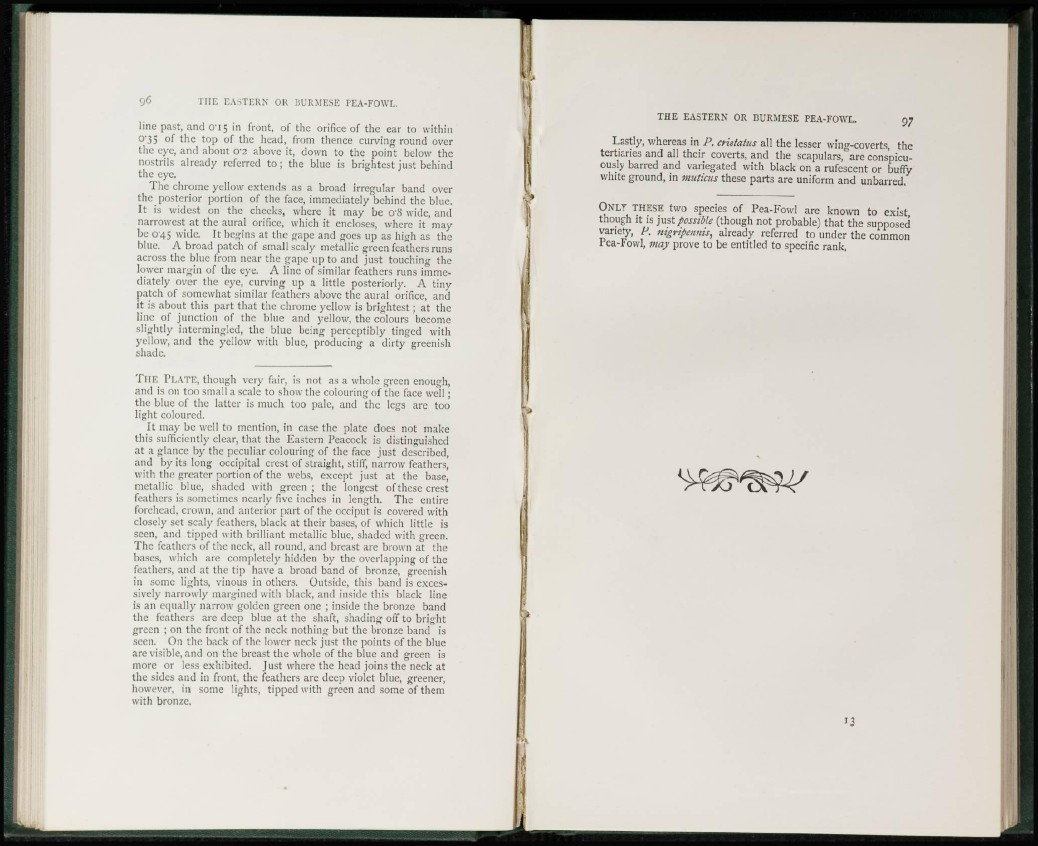
line past, and 0 ' I 5 in front, of the orifice of the ear to within
0'35 of the top of the head, from thence curving round over
the eye, and about 0'2 above it, down to the point below the
nostrils already referred to ; the blue is brightest just behind
the eye.
The chrome yellow extends as a broad irregular band over
the posterior portion of the face, immediately behind the blue.
It is widest on the checks, where it may be o'8 wide, and
narrowest at the aural orifice, which it encloses, where it may
be 045 wide. It begins at the gape and goes up as high as the
blue. A broad patch of small scaly metallic green feathers runs
across the blue from near the gape up to and just touching the
lower margin of the eye. A line of similar feathers runs immediately
over the eye, curving up a little posteriorly. A tiny
patch of somewhat similar feathers above the aural orifice, and
it is about this part that the chrome yellow is brightest; at the
line of junction of the blue and yellow, the colours become
slightly intermingled, the blue being perceptibly tinged with
yellow, and the yellow with blue, producing a dirty greenish
shade.
THE PLATE, though very fair, is not as a whole green enough,
and is on too small a scale to show the colouring of the face well ;
the blue of the latter is much too pale, and the legs are too
light coloured.
It may be well to mention, in case the plate does not make
this sufficiently clear, that the Eastern Peacock is distinguished
at a glance by the peculiar colouring of the face just described,
and by its long occipital crest of straight, stiff, narrow feathers,
with the greater portion of the webs, except just at the base,
metallic blue, shaded with green ; the longest of these crest
feathers is sometimes nearly five inches in length. The entire
forehead, crown, and anterior part of the occiput is covered with
closely set scaly feathers, black at their bases, of which little is
seen, and tipped with brilliant metallic blue, shaded with green.
The feathers of the neck, all round, and breast are brown at the
bases, which are completely hidden by the overlapping of the
feathers, and at the tip have a broad band of bronze, greenish
in some lights, vinous in others. Outside, this band is excessively
narrowly margined with black, and inside this black line
is an equally narrow golden green one ; inside the bronze band
the feathers are deep blue at the shaft, shading off to bright
green ; on the front of the neck nothing but the bronze band is
seen. On the back of the lower neck just the points of the blue
are visible, and on the breast the whole of the blue and green is
more or less exhibited. Just where the head joins the neck at
the sides and in front, the feathers are deep violet blue, greener,
however, in some lights, tipped with green and some of them
with bronze.
THE EASTERN OR BURMESE PEA-FOWL. 97
Lastly, whereas in P. cnstalus all the lesser wino-coverts the
tertiaries and all their coverts, and the scapulars,°are conspicuously
barred and variegated with black on a rufescent or buffy
white ground, in muticus these parts are uniform and unbarred.
ONLY THESE two species of Pea-Fowl are known to exist
though it is just possible (though not probable) that the supposed
variety, P. nigripennis, already referred to under the common
Pea-Fowl, may prove to be entitled to specific rank,